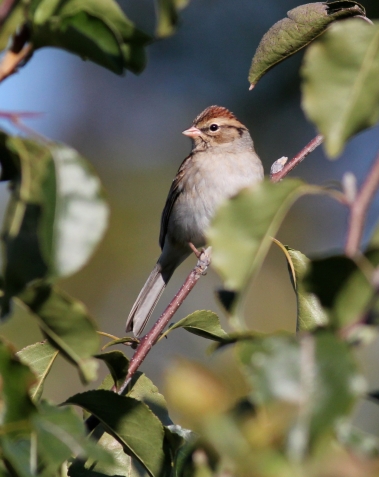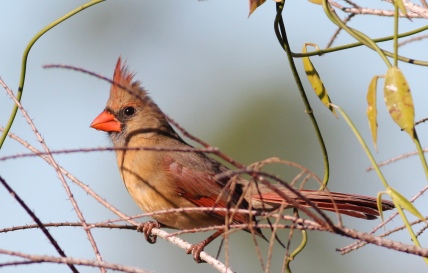It seems trite to observe that every year is different, but this year it is certainly true. I migrated northward on four wheels via Interstate 95 at 70 miles per hour while the birds were paralleling my route overhead along the Atlantic Flyway. They were somewhat slower than me but did not have to contend with bathroom breaks, masks, and gasoline. My migration from South Florida to Maryland was a substantial 1100 miles, but many of the birds far surpassed this distance.
I’ve been away from my patch on San Domingo Creek, a tributary of the Chesapeake Bay, since the start of winter and Mother Nature, both its flora and fauna, have tried to take over. The grass and weeds are out of control, limbs are down from winter winds that have even dislodged planks from the dock. Deer, Red Fox, Squirrels, and Insects have had a lark with the vacant property. Even some of the birds need to be put back into their proper place. Homo sapiens has returned.
The White-throated Sparrows, Juncos, Loons, migrating Canada Geese, and Tundra Swans have all exited to the north, but countless migrators have moved in from the south to replace them. The competition for territories, mates and nesting sites has begun in earnest.
The male Red-winged Blackbirds are early birds on the scene and stake out prime nesting sites along the brackish cove, hoping their choice of real estate, along with their pleading trill, entice a mate. This bird is a short distance migrator with the Chesapeake near the northward margin of their wintering grounds.
A more accomplished migrant, the Eastern Kingbird, arrived at my patch before me and established its customary territory on the north side of the house in the old oaks. They made the trip from the western Amazonia region of South America, perhaps eastern Ecuador or Peru.
I like to think of these flycatchers, wintering in the Andes but still retaining that vague recollection or imprinting on their brains that brings them back over the many miles to this specific patch they left last fall. I gladly welcome them home and observe again the truce these feisty birds, (check out their Latin name) have arranged with the equally territorial Northern Mockingbirds. The Mockers were here all winter but seem to tolerate the Kingbirds, perhaps as a herald of spring and better days ahead. Just stay on your side of the house.
The Osprey also beat me home. Luckily neighbors on both sides have platforms just off shore, so there was no need for me to crowd in another. The fishing prowess and flight antics will provide a wonderful show all summer. I’ve often wondered about their migration, given the year-round Osprey and active nests I see along Florida’s gulf coast all winter.
I’ve learned that those Florida Osprey have become a non-migratory population, whereas our Chesapeake birds have wintered further south in the Caribbean and Central America. As they overfly Florida you wonder if they ever look down with envy at their cousins who are enjoying a more sedentary life in the sunshine state.
Speaking of nonmigratory, please make those ornery residential Canada Geese go away. Every year their ranks grow and these bold, fat birds refuse to yield when I return home. They’re giving geese a bad name in these parts. The fall-seeded lawn is practically bare from their work and their turds fill the pool. They are not dumb and have figured out that a half dozen in the middle of the mesh pool cover weighs it down enough to create their own private pond. They have the audacity to honk at me when I break up the party and chase them away. I did notice only one small gosling in the flock this year. The Red Fox did look well fed when he pranced by yesterday.
The loud keyew, keyew, of the Osprey dominates the avian chorus on the waterside, but the newly arrive Chipping Sparrow holds its own on the land side of the patch, even among the residential choir of Northern Mockingbirds, Cardinals, and Carolina Wrens. There seems to be more than ever of these rufous-headed migrators in the Loblolly pines. They’ve wintered along the southern U.S. border, Mexico, and Central America.
The Least Terns I saw fighting over a small fish, scolding each other with their high-pitched chippering, are also new arrivals. Their wintering grounds are not well established, but is likely off the coasts of Caribbean islands and Central America.
I put new roofs on the bluebird houses last fall and am pleased to see a breeding pair move into the best water view house. These are beautiful year round residents of the patch and at least this year they beat the migrating Tree Swallows to the prime real estate. The swallows have returned from the southern states and Central America but will have to settle for the lower rent houses.
I tried to be a nice guy and hung the “squirrel proof” feeder by the pool, but those dastard varmints, frustrated by the cage, just ate through the hanging rope and enjoyed a feast when it crashed to earth and scattered the sunflower seeds. But I fixed their wagon and won round one. It now hangs by a steel cable. The European Starlings are dumber, but equally persistent. I’ve now cleared out their nest from the housing of the boat lift motor twice. Last year it took five evictions before they learned.
Yesterday the bird du jour on my patch walk was a Spotted Sandpiper seen bobbing along the cove’s mudflat at low tide. I only got a brief look before it spooked, but the ID was definite. This bird, our most widespread breeding sandpiper in North America, also migrated from Central and South America and may choose to breed here or continue further north into Canada. I have yet to get a good picture of this shorebird.
It’s the female of this species that arrives first in the spring, chooses a territory, and attracts an interested male. When the eggs hatch the male takes on the leading parental role while the polyandrous female moves on to another mate. How many times she pulls this off per season is unclear.
My only other innovation this spring is a small solar-powered fountain to go in the large concrete birdbath. I’m hoping the aeration will hold down the algae growth and cleaning chores. The birds may also welcome an occasional shower. The reviews seem too good to be true, but I’ll let you know. In the meantime, stay well.

















Awesome pictures!
LikeLiked by 1 person
Thanks. I enjoyed putting it together.
LikeLiked by 1 person
Nice homecoming for a nature lover. Nature has to make room for Homo sapiens now!
LikeLiked by 1 person
Yes, there’s plenty of nature up here in Maryland, although I do miss those warmer and sunnier Florida days. My last social outing was way back in March when we joined you for the sunset cruise. It now seems like ages ago. Good to hear from you and thanks for commenting.
LikeLiked by 1 person
A delightful return – your commentary is highly entertaining and, of course, your photographs are a joy.
LikeLiked by 1 person
There’s always something special about coming home, whether you’re a Kingbird or just a human. Glad you enjoyed the post; I enjoy your thoughtful comments.
LikeLike
Spectacular photos and great read, very much enjoyed!
LikeLiked by 1 person
So glad you enjoyed it. Blogging is great entertainment, as you know, especially these days.
LikeLiked by 1 person
Hi Steve—. Welcome back! I posted a long comment but don’t see it listed. Please let me know if you got it. Forest
Sent from my iPhone
>
LikeLiked by 2 people
It is good to be home again. I actually enjoy these outdoor tasks in the yard, especially with the “lockdown” persisting. I did not get your longer comment, but thanks for the effort.
LikeLike
Where would it have gone? At the end, I filled in the boxes of name and email, and then was prompted to sign in with my password, which seemed to work.
LikeLiked by 1 person
Forest, It’s in the unknown vapor of cyber space. It happens, and we’ll never know why.
LikeLike
What a pleasurable read! I particularly enjoyed your photos of some of the north American species that I got to know when we visited the USA and Canada a few years ago
LikeLiked by 1 person
Thanks for that kind comment. I hope to resume international travel once this virus dies down, and check out more of your birds as well.
LikeLiked by 1 person
Love the boldness of the Red-winged Blackbird! Great photography. William – “What a wildly wonderful world, God! You made it all, with Wisdom at Your side, made earth overflow with your wonderful creations.” Psalms 104 The Message
LikeLiked by 1 person
Thanks for that and Amen.
LikeLiked by 1 person